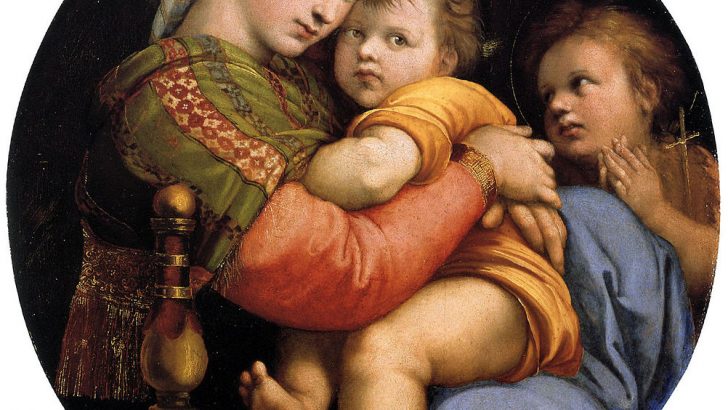Raphael’s World
by Michael Collins (Messenger Publications, €19.95 / £17.95)
The Renaissance painter Raphael (1483-1520) is an artist whose work is widely familiar to many people without them being aware of it. His images affect their imagination because of their content, not because of whom they are by. This is because (rather like Murillo) he was a source of prints for many ‘holy pictures’. These hung in so many convents, school and colleges that few Catholics can have avoided them before the 1970s.
Certainly in the large junior class room in the Sacred Heart in Leeson Street over the fireplace there hung a copy of Raphael’s Madonna della Segiola (c. 1514). Outside of the pictures at home I think this was the first real painting that affected me as a very small child: it seemed to sum up so much about the nature of motherly love, and so of love itself. I had never heard of Raphael, of course, but could recognised what this picture was about, an essentially warm human scene.
His religious paintings are just one topic explored by Fr Collins”
To provide holy pictures may seem an unkind fate, one the painter did not deserve, but careful scholarship has thankfully preserved him from that. But the pervasive influence of early images cannot be escaped. In that sense then Raphael is one of the great painters of Western culture. He is one of the great past masters, not just of art, but of religious art in particular.
His religious paintings are just one topic explored by Fr Michael Collins in his new book, published to mark the 500th anniversary of the death of ‘the divine painter’ which falls this year. In this concise but detailed book he manages within a very limited space to provide an exemplary account of the painter, his era, his life work and influence which could not be better for a beginner.
He also explains that there are still many unresolved mysteries about his life, his career, his sitters and their identity, and his relations with other great artists of the day. The size of his book precludes very extended illustration, but it provides an excellent introduction which will lead to a long period of happy exploration for those who fall under his particular spell.
An annotated list of some essential books about Raphael for further exploration would have been useful.
A book of this kind is only a departure, not a final stop.
There are seven paintings and drawing by Raphael in the National Gallery. They will be there to be explored another time; but in the meantime many will enjoy this encounter with a great painter until they are open again.
It is great to see a new book from Fr Collins, who has suffered ill health over the last few years. His friends and readers will look forward to more books from his ready and well-informed pen – or should that word processor in these days.


 Peter Costello
Peter Costello La Madonna della seggiola
La Madonna della seggiola 